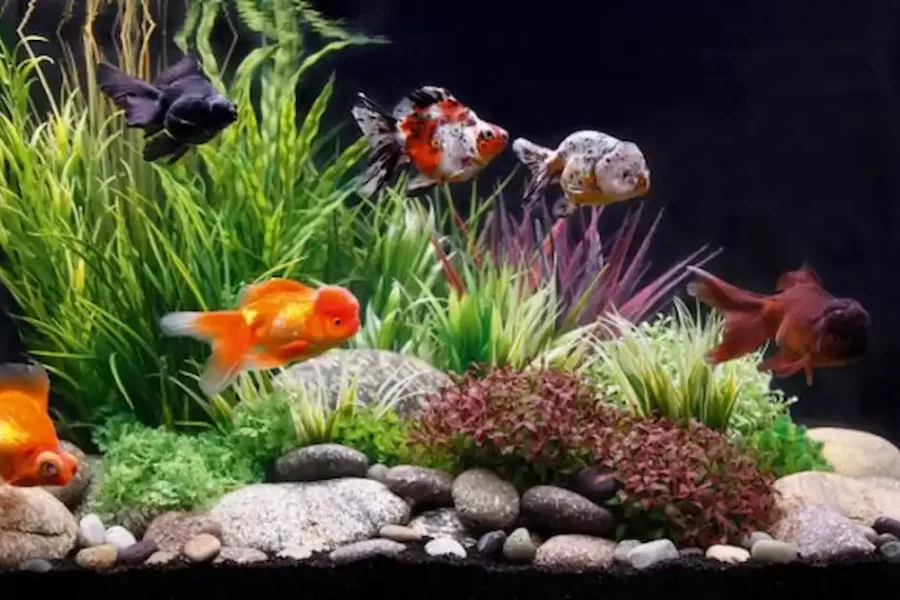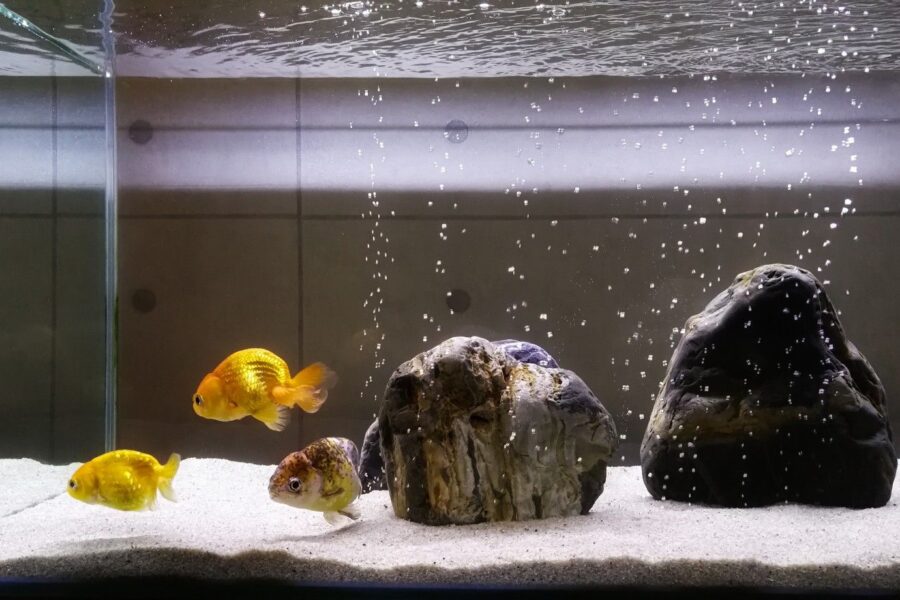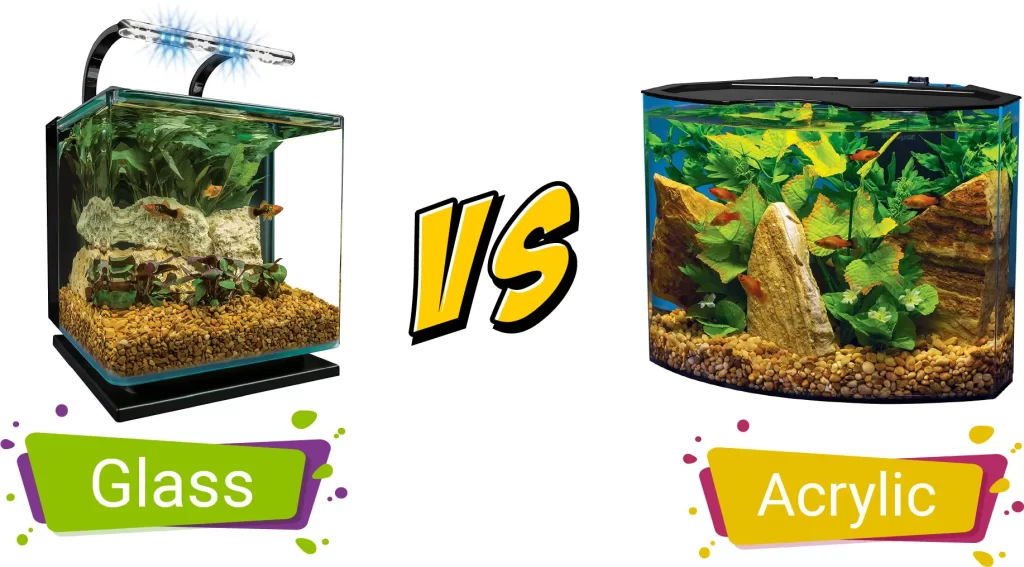
Welcome to “The Big Debate: Glass vs. Acrylic.” Here, you’ll dip your toes into the make-or-break world of fish tanks, exploring the epic historical stand-off between glass and acrylic tanks, and unraveling why the material of your goldfish’s humble abode is a lot more than just a matter of aesthetics.
Next up, we’ll wade into the nitty-gritty of glass tanks – assessing their durability, visual appeal, cost and squeaky-clean upkeep. Likewise, we will dive into the sea of factors that outline the pros and cons of stylishly modern, yet scratch-prone, acrylic tanks. So, buckle up, fish enthusiasts, for a fin-tastic journey into the marine habitat of your goldfish’s dreams!
The Big Debate: Glass vs. Acrylic
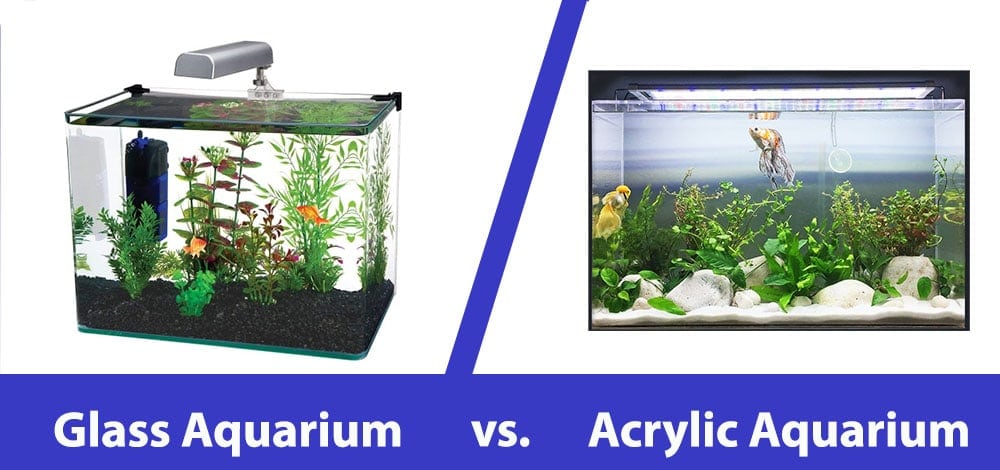
Hold your horse and don’t head to the pet store just yet! We need to talk about the great debate in the goldfish community: glass vs. acrylic. Yup, we’re pitting these two materials against each other to see which one gets the trophy in tank material Olympics!
Historical Comparison Between Glass vs. Acrylic Tanks
Glass fish tanks have been around since the mid-19th century – that’s like forever in goldfish years! But acrylic tanks? They didn’t enter the scene until the 1970s. From then, it’s been an epic battle kind of like Batman vs. Superman, but with less capes and more water.
Why the Material of the Tank Matters
Oh, you thought all a goldfish wanted was a castle and some food flakes? Think again! The material of their tank matters big time. It’s like us living in a house made of glass or wood – different materials, different vibes, or with Frame or Frameless. Plus, the material impacts practical factors like weight, durability, and visibility.
Stay with me now and prepare to dive deeper into the world of fish tank materials. We’ll kick start with the heavyweight contender: glass!
The Rundown on Glass Tanks
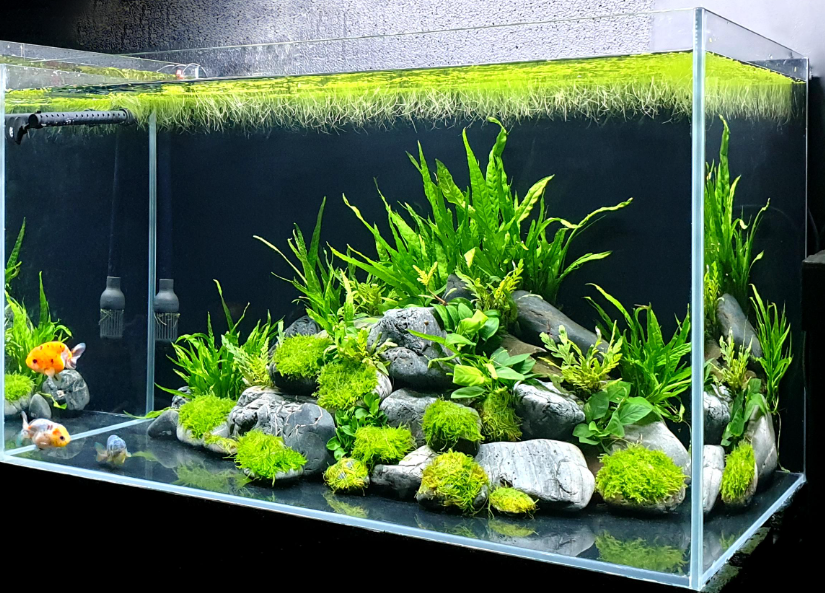
Before we dive into the acrylic vs. glass debate, let’s first take a gander at the pros and cons of glass goldfish tanks.
The Hard Truth About Durability and Longevity
Glass tanks have been around forever. They’re the grandpa of the aquarium world, both due to their age and rugged dependability. Glass scratch-resistant properties make them resilient and longer-lasting than their acrylic counterparts. Quite the sturdy chap, if you ask me!
Dinged your coffee table trying to relocate your tank? Odds are, your glass goldfish tank took it in stride. But, remember, sturdiness has a significant opponent – gravity. So, no skydiving with your glass tank!
Seeing Clearly: Visual Clarity and Aesthetics
Are you the type of person who wants to see every detail of your goldfish’s happy little face? If so, glass tanks might just be your best pal. Despite ups and downs, they never lose their clarity – perfect for admiring your Googly and Moogly late into the night!
What’s more, glass remains indifferent to UV rays. You can even take sunbathing selfies with your goldfish if you fancy! But remember, no sunglasses for them.
Price and Availability – Will It Break the Bank?
Pouring cold water on the burning glass love, glass tanks are often more expensive than their acrylic rivals. But do not despair, my penny-saving comrades! Most pet stores and online retailers generally possess a good stock due to the high demand.
Can’t find a decently priced glass tank? Calm those sweaty palms! A good deal might be waiting just around the corner.
Scrub-a-Dub: Maintenance and Cleaning
Cleaning can suck the joy out of even the most delightful hobbies. But with glass tanks, cleaning becomes less of a dreaded chore. Glass doesn’t absorb chemicals like acrylic does, making scrubbing easier than coaxing a shy goldfish out for feeding time.
So, you’ve got extra pool time with your friendly little gold nuggets. And they? A cleaner, sparkling tank! But wait–don’t dive head-first into the glass ocean yet. The acrylic tanks are not out of the race. Let’s see how they fare in the next section.
Pros and Cons of Acrylic Tanks
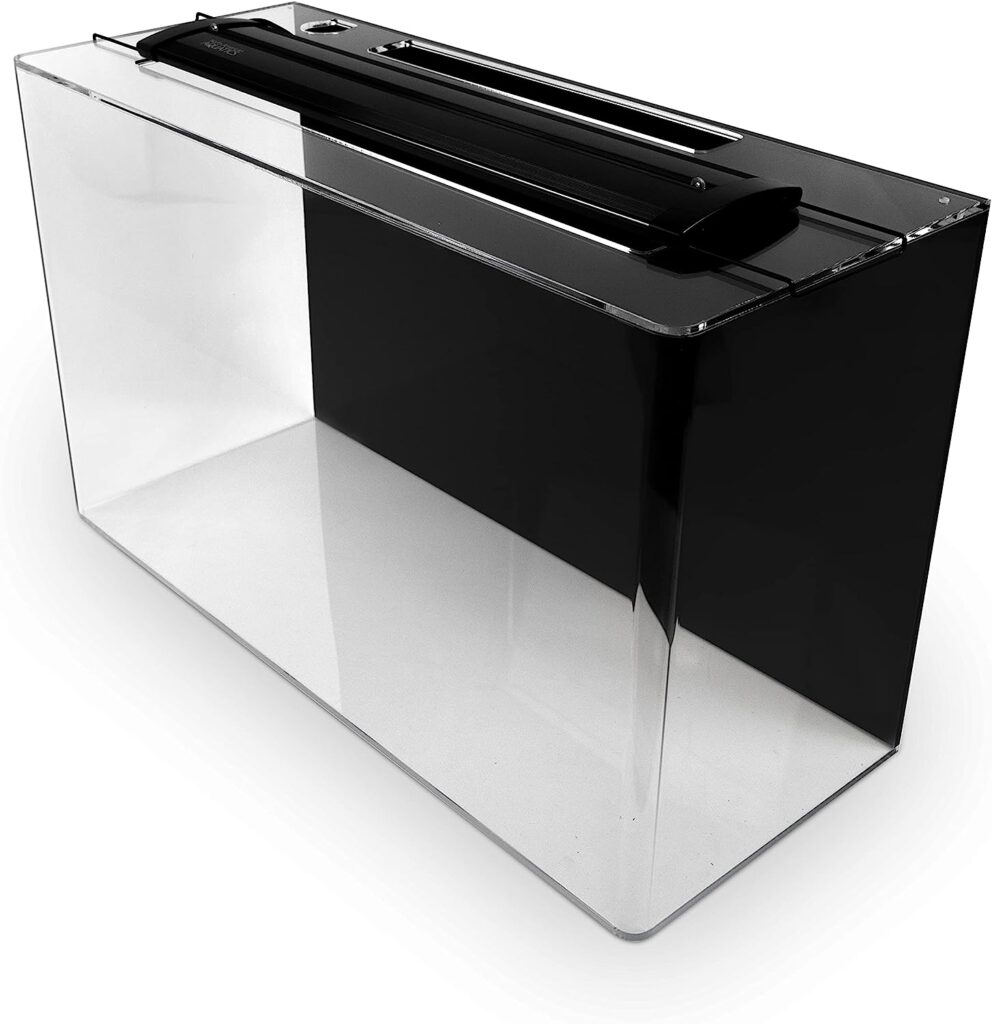
Welcome to the world of acrylic tanks, a place where weightlifting isn’t a prerequisite for ownership.
Lightweight and Flexible Design Options
Acrylic goldfish tanks are an unappreciated star when it comes to portability. Their lightweight profiles make moving and repositioning your fish’s kingdom an absolute breeze. Plus, they’re a dream for those with a keen design eye. They come in a broad spectrum of shapes and sizes, making it easier to match your interior decor or express your personality.
Alright, moving forward, we’re going to dip our toes into the downsides of acrylic tanks. BRACE yourselves!
Potential for Scratches and Yellowing
Let’s face it, folks. Aesthetic appeal is a significant part of our goldfish’s luxury condo, I mean tank! Acrylic, my friends, is a bit of a diva in this department. It’s notorious for scratching more easily than glass, and the last thing we want is a front-row seat to scratchyview instead of Fishville. Additionally, over time, it could potentially yellow with age, like a vintage photograph. But your goldfish palace ought to be HD, right?
Hold onto your tank cleaners. We’re about to dive into another important aspect – price comparison.
Price Differences Compared to Glass Tanks
Move over, diamonds. Acrylic tanks may take the title of ‘girl’s best friend’…Oops, I meant ‘goldfish’s best friend’. Why, you might ask? They tend to be more pricey than their glass counterparts! Yes, sometimes it’s all about ‘pay a little more now, groan a little less later when moving it’.
Last, but not least on our list, let’s talk about cleanliness. Because nobody wants a goldfish tank that looks like a swamp.
Maintenance and Cleaning Requirements
Cleaning an acrylic tank requires a gentle touch and proper tools to avoid scratches. It’s a tad more demanding because it wants your pampering without dulling its sparkle. Rinse gently, my friends, and NO SCRUBBING BRUSHES! Our goal is crystal clear views, not ‘Spot the Scarface’.
So what’s the takeaway? Acrylic tanks are lightweight, versatile in design, but need you to handle them like a china doll. They’ll make your wallet ‘ouch’ a bit, but hey, who said pampering Genie (the goldfish) was going to be cheap?
Keep swimming with me, folks. Our dive is not over yet. Next up, we’ll uncover the factors you need to consider when choosing your goldfish’s watery real estate.
Considerations When Choosing Tank Material
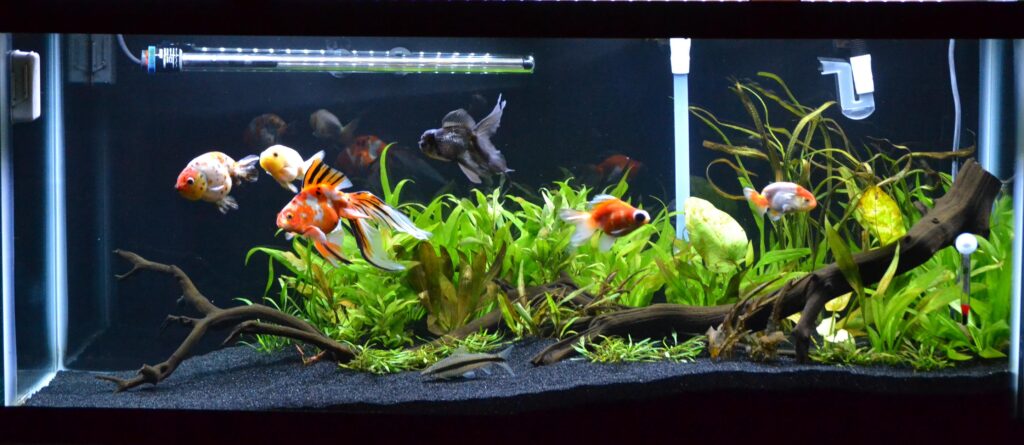
Before you rush out and buy the first tank you see, remember – different strokes for different folks. And by folks, I mean goldfish. It’s not just about what you like. It’s important to keep your slippery friend’s wants and needs in mind, too.
Think About Your Goldfish’s Needs
A goldfish is like a toddler – it needs space to play, but not so much that it can get lost. And just like toddlers, they’re messy. No, they don’t fling spaghetti on the walls, but they can muck up their water quite quickly. Based on their size, variety and number, you’ll need to choose a tank that’s spacious enough and has a good cleaning system in place.
Consider Your Home Environment and Available Space
Secondly, think about your home space. An aquarium won’t fit if you’re living in a shoebox apartment, metaphorically speaking. And if you’re the clumsy sort, navigating around a glass behemoth could lead to disaster. Take a good look around and decide where your tank will live happily ever after.
Budget and Long-Term Care Costs
Let’s face it – fish can be high-maintenance. The initial setup cost aside, you’re signing up for regular cleaning, water changes, and health check-ups. Don’t forget the potential for tank mishaps. Calculate your budget before you dive headfirst into this lifelong commitment.
Remember, choosing a goldfish tank is not ONLY about glass or acrylic. It’s more complex, much like deciding between cake and ice cream. They both have their merits, but the choice should ultimately suit your style and situation. Next up, we’ll explore what experts have to say about the face-off between glass and acrylic tanks. Stay tuned.
Expert Opinions and Recommendations

So, we’ve covered the nitty-gritty of glass and acrylic tanks. Now let’s dish out the juicy details from reliable sources. We’re talking expert opinions, reputable brands, and real-life tank tales.
Reputable Brands for Both Glass and Acrylic Tanks
Navigating the sea of tank producers can make even a fearless fish dizzy. To help you out, we’re casting the spotlight on two major players in this game. In the glass corner, we have “Aqueon Aquarium“, adored by fanatics for their crystal-clear, durable tanks. Flying the flag for acrylic is “SeaClear“, a brand renowned for its feather-light and flexible designs.
Case Studies of Successful Goldfish Tanks
There are some seriously passionate goldfish guardians out there. Let’s dip our fins into the success stories of two such enthusiasts. First up, Adele-the-aquarium-aficionado, who swears by her 75-gallon Marineland glass kingdom. She loves its hardy constitution and the clear-as-day display of her goldfish community. Then, we have Bob-the-builder (of tanks, not the cartoon character), who can’t get enough of his SeaClear tank. He adores the malleability that lets him add trinkets, toys, and excess amounts of goldfish goodies.
Final Verdict on The Best Material
Drumroll, please! The time has come to select our tank champion. But wait a second, aren’t we forgetting something here? Oh right, your specific needs and circumstances! The truth is, both glass and acrylic have their perks and weaknesses. Your decision should hinge on the factors we’ve discussed: durability, clarity, price, and maintenance. Oh, and of course, what your goldfish would pick if they could (we’re still working on that fish-to-human translator).
From here, we’re splashing over to the concluding section. So tighten your goggles as we wrap this deep dive up, summarizing the key points, and sending you off with a tidal wave of knowledge to choose your goldfish tank-material match.
Wrap Up
Having delved into the intricate aspects of the Glass vs. Acrylic debate, we can confidently conclude that both materials carry their own weight. Despite the extensive development of tanks throughout history, the right choice profoundly depends upon one’s specific conditions and preferences. It’s a delicate balance of durability, expense, visual delight, and maintenance.
Summing up the expert opinions, recommendations and case studies, no clear-cut victor arises in the face-off between glass and acrylic tanks. Instead, the decision should primarily stem from considerations like your goldfish’s needs, available space, budget, and long-term care plans. So, make an informed decision, provide your fish with the ideal home, and keep enjoying the captivating sight of your graceful, aquatic friends.
Frequently Asked Questions (FAQ)
Question: Is a glass or acrylic tank better for my goldfish?
Answer: There is no one-size-fits-all answer to this question. The choice of tank depends on factors like durability, visual clarity, price, and maintenance requirements. Review the pros and cons of each to make an informed decision.
Question: Does the material of the fish tank affect my goldfish’s health?
Answer: Yes, your tank’s material can affect your goldfish’s health. For example, acrylic tanks can yellow over time, reducing light penetration which can affect your goldfish’s well-being.
Question: Which tank is easier to maintain — glass or acrylic?
Answer: Acrylic tanks are generally easier to maintain because they are lighter and easier to move around. However, they scratch more easily than glass tanks, so extra cautiousness is required during cleaning.
Question: Are acrylic tanks more expensive than glass tanks?
Answer: Prices can vary depending on the size and brand of the tank. While acrylic tanks are often pricier, they offer more shape variety and are lighter, which may justify the extra cost to some fish enthusiasts.
Question: Can glass tanks break easily?
Answer: Glass tanks are pretty durable and have a longer lifespan than acrylic tanks, but they can break if subjected to significant stress or impact. Always handle your tank with care, regardless of its material.
Question: Where can I find reputable brands for both glass and acrylic tanks?
Answer: You can find trusted brands at your local pet store or at Amazon. We will discuss some recommended brands in the ‘Expert Opinions and Recommendations’ section of the full article.

